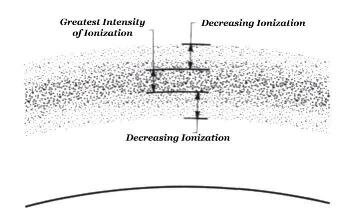
Radio-Wave Propagation
The sun has a large effect on long-distance radio communication on Earth. Solar flares, as well as sun spots, can make long-distance communication possible . . . or impossible.
|
To Engage Multimedia Mode Press Play |
There are several ionized regions which appear at different heights in the atmosphere. Each region has a central region where the ionization is the greatest. The intensity of the ionization decreases above and below the central area in each region.

The ionosphere consists of several regions of charged particles. These regions have been given letter designations. Scientists started with the letter D just in case there were any undiscovered lower regions.

The D region:
The lowest region of the ionosphere affecting propagation is the D region. This region is in a relatively dense part of the atmosphere about 35 - 60 miles above the Earth. When atoms in this region absorb sunlight and form ions, the ions don't last very long. They quickly combine with free electrons to form neutral atoms again. The amount of ionization in this region varies widely, as it depends on how much sunlight hits the region. At noon, D region ionization is maximum or very close to it. By sunset, this ionization disappears. The D region is ineffective in refracting or bending high-frequency signals back to Earth. The D region's major effect is to absorb energy from radio waves. As radio waves pass through the ionosphere, they give up energy which sets some of the ionized particles into motion. Effects of absorption on lower frequencies are greater than on higher frequencies. Absorption also increases when there is more ionization. The more ionization, the more energy the radio waves lose passing through the ionosphere. Absorption is most pronounced at midday. It is responsible for the short daytime communications ranges on the lower-frequency bands (160, 80, and 40 meters).
The E region:
The next region in the ionosphere is the E region, at an altitude of 60 to 70 miles. At this height, ionization produced by sunlight does not last very long. This makes the E region useful for bending radio waves only when it is in sunlight. Like the D region, the E region reaches maximum ionization around midday. By early evening the ionization level is very low. The ionization level reaches a minimum just before sunrise, local time. Using the E region, a radio signal can travel a maximum distance of about 1,250 miles in one hop. Sporadic E or E skip, is a type of sky-wave propagation that allows long-distance communications on the VHF bands (6 meters, 2 meters, 222 MHz). Although, sporadic E only occurs during certain times of the year, it is the most common type of VHF sky-wave propagation.
The F region:
The region of the ionosphere most responsible for long-distance amateur communication is the F region. This region is very large and ranges from about 100 to 310 miles above the Earth. The height depends on season, latitude, time of day, and solar activity. Ionization reaches a maximum shortly after noon local standard time, and tapers off very gradually towards sunset. At this altitude, the ions and electrons recombine very slowly. The F region remains ionized during the night, reaching a minimum just before sunrise. After sunrise, ionization increases rapidly for the next few hours. Then it increases slowly to its noon time maximum.
During the day, the F region splits into two parts, F1 and F2. The central part of F1 region forms at an altitude of about 140 miles. For the F2 region, the central region forms at about 200 miles above the Earth. These altitudes vary with the season of the year and other factors. At noon in the summer the F2 region can reach an altitude of 300 miles. At night, these two regions recombine to form a single F region slightly below the higher altitude. The F1 region does not have much to do with long-distance communications. Its effects are similar to those caused by the E region. The F2 region is responsible for almost all long-distance communication on the amateur HF bands. A one-hop radio transmission travels a maximum of about 2,500 miles using the F2 region.
Scattering influences all electromagnetic-wave propagation. This alters the idealized patterns to a great degree. The Earth's atmosphere, ionospheric regions, and any objects in the path of radio signals scatter the energy. By understanding how scattering takes place, we can use this propagation mode to our advantage.
There is an area between the outer limit of ground-wave propagation and the point where the first signals return from the ionosphere. The skip zone is often described as if communications between stations in each other's skip zone were impossible. But, some of the transmitted signal is scattered in the atmosphere, so the signal can be heard over much of the skip zone. You usually need a very sensitive receiver and good operating techniques to hear these signals, as they are usually weak and distorted.
You can observe a complex form of scatter when you are working very near the MUF. The transmitted wave is refracted back to Earth at some distant point. A portion of the transmitted signal reflects back into the ionosphere. Some of this signal comes toward the transmitting station. The reflective wave can help fill the skip zone.

Scatter signals are generally weak and subject to distortion, because the signal can arrive at the receiver from many different directions. This type of scatter propagation is usable from just beyond the local range out to several hundred miles. Under ideal conditions, scatter propagation is possible over 3,000 miles or more. This form of propagation is sometimes called "backscatter", but the term "sidescatter" is more descriptive of what happens on such long paths.
"Ham-Shack.com", Copyright 1997-2009 Jonathan and Sara Imberi All rights reserved.